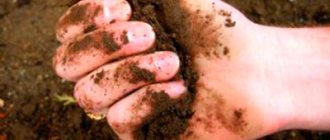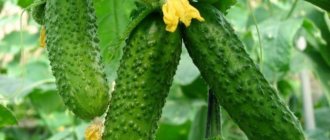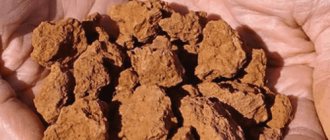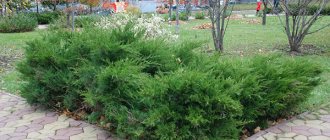How to determine acidity?
It is quite easy to set this indicator at home. To do this, in a specialized store you need to buy a kit for measuring soil acidity, which includes a certain number of litmus papers. In addition, you need to prepare a so-called soil extract (add five parts of water to one part of the soil). The container with this extract needs to be shaken thoroughly and left alone for a while to allow it to settle. Now you can place litmus paper in the liquid that is located above the sediment. Upon contact with liquid, it changes its color, which is compared with the template.
Acidic soil, the symptoms of which are described in this article, is characterized by the following colors on a piece of paper: green, blue-green and blue.
How to normalize acidity (deoxidize)?
All these remedies will help normalize the acidity of the soil.
The easiest way to neutralize the soil is liming , which involves adding calcium to the soil. This cheap product, in addition to normalizing pH, has a positive effect on garden crops, as it is a nutrient for them. Liming helps improve the structure of the soil, makes it more crumbly, and creates conditions for the growth of beneficial bacteria. Magnesium has a similar effect.
For deoxidation, you can use chalk , slaked lime , ground limestone (contains calcium and magnesium), and dolomite flour . For the procedure to be most effective, the product should be thoroughly crushed - the smaller the particles, the better they will interact with the substances contained in the soil. Additionally, before adding, they can be sifted through a fine sieve.
Another remedy that helps improve pH is stove and peat ash . Just like lime, they additionally have a nourishing effect on growing crops. The disadvantage of this remedy is that its effect is less pronounced.
According to the strength of action, the substances used for neutralization can be arranged in a row. Slaked lime comes first, followed by dolomite, calcium carbonate and limestone, which are of average effectiveness. In last place is ash, the use of which produces a short-term change in pH.
It is better to choose a product depending on how acidified the soil is. If the pH is slightly reduced, it is better to take ash, and if this indicator is less than 4.0, only slaked lime will do.
Gypsum, which contains sulfur, which prevents soil deoxidation, should not be used for alkalization. Calcium chloride should not be used either, since chlorine has a similar effect.
If you need to acidify neutral soil, I recommend adding a small amount of nitrogen fertilizers (ammonium sulfate), high-moor peat or soil with pine needles. Colloidal sulfur also has a good effect.
What plants indicate acidic soil?
Acidic soil (how to determine it at home is indicated above) is loved by many plants, despite the fact that its presence in the garden or personal plot can cause many problems.
Plants that live exclusively on such soils are called acidophiles. Knowing which wild herbs love such soil, you can determine acidity without chemical tests. On such soils the following most often grow:
- horsetail;
- small sorrel;
- moss;
- caustic buttercup;
- blueberry;
- sorrel;
- on slightly acidic soils you can find heather, cornflowers and ferns.
However, it is worth considering the fact that many plants are indifferent to small fluctuations in this indicator, that is, they are able to adapt to edaphic factors (the combination of the chemical properties of the soil and its physical characteristics). Therefore, for a more accurate result, it is recommended to determine the amount of alkaline elements in the soil using a litmus test.
If we talk about gardening crops, then acidic soil (its signs are very easy to remember) will not be to the taste of any of the famous representatives. It is possible for some of them to grow at a pH closer to neutral, for example, quince, various varieties of apple trees, raspberries and blackberries, as well as tomatoes, sorrel, zucchini, potatoes and pumpkin. Knowing the signs of acidic soil in the garden, improving the condition of the soil is quite easy. This is possible by adding certain substances. Among the flower representatives of the plant world, acidic soil (how to deal with it can be found in the article) is suitable for irises, delphiniums, some lilies, conifers and most roses.
Causes of soil acidification
The more hydrogen ions the soil contains, the more acidic the reaction. To determine the type of soil, pH is used. Values ranging from 6 to 8 indicate a neutral environment.
The popular bookmaker has released a mobile application for Android, you can follow the link absolutely free.
Expert opinion
Elena Pchelkina
Gardening Expert
Anything below 6 is acidic, anything above 8 is alkaline. Soil with a pH of 4.0 or less is considered the most acidic.
An acidic environment appears due to the natural processes of air exchange in the soil, plant respiration and decay with the release of carbon dioxide.
Carbon dioxide reacts with water to form weak carbonic acid. It destroys calcium and magnesium compounds, there are more hydrogen ions in the soil, and the pH reaction sharply decreases to 4-5.
Signs of soil acidification and which plants help combat the problem
Nitrogen fertilizers and acid rain acidify the soil.
Other detection methods
A special Alyamovsky device can help in determining acidity. This is a set of special reagents, the main purpose of which is to analyze soil extracts (for comparison, two extracts are taken: salt and water). It also includes an indicator, potassium chloride solution, test tubes and samples. The analysis is similar to that used with litmus strips.
There is also a device that is designed to determine the acidity of the soil, while performing several functions at once:
- determination of acidity;
- humidity;
- temperature;
- soil illumination.
There are also traditional methods. For example, using cherry or currant leaves. They need to be brewed with boiling water and then cooled. Next add some soil. The acidity of the soil is determined by the color of the liquid. If the water changes its color to red, then the soil is acidic.
How does soil acidity affect plants?
To obtain a large amount of harvest, soil acidity is a very important parameter that should be taken into account when choosing plants. This is necessary to ensure that plant nutrition is not disrupted, as well as the process of assimilation of elements necessary for full development. If unadapted specimens are planted on acidic soils, this risks nitrogen starvation, especially under unfavorable climatic conditions, in particular during rains and low temperatures. A manifestation of this is considered to be leaf chlorosis, which begins to absorb the plant from the veins and then spreads to adjacent tissues. In order not to be confused with natural aging, remember that the latter begins with the tissues between the veins, and the veins themselves remain green for some time.
In addition, acidic soil (what grows on it is indicated above) is characterized by the transition of aluminum and iron into salts, and this risks the fact that phosphoric acid is simply not absorbed by plants. A high amount of these salts in the soil can lead to the fact that calcium, potassium, phosphorus, magnesium and molybdenum practically do not penetrate into plant tissues and contribute to a decrease in yield. Other elements, such as copper, boron and zinc, also become phototoxic. Plants that are not adapted to grow in acidic soil develop poorly, root branching is suspended, the absorption of water and other nutrients is significantly deteriorated, signs of acidic soil on the site prove this.
In addition, such soil can become waterlogged, and the lower the pH level, the greater the likelihood of waterlogging.
Determining soil acidity
Method 1
To determine the acidity of the soil in your area, it is not at all necessary to call specialists. You can simply purchase universal litmus paper at the pharmacy and take several soil samples from your area. Each of them should be wrapped in pieces of thick fabric and placed in separate glasses with water (the ratio of water and soil is 1:1). It is best to take distilled or rain water.
After 5 minutes, you need to place litmus paper in each container. This needs to be done very quickly: just dip a piece of paper in water for 1-2 seconds or apply a drop of liquid to it. The indicator paper will change color, by which you can determine the acidity of a particular soil sample. As a rule, an acidity scale is attached to the indicator paper.
Soil acidity scale
Method 2
You can determine the acidity of the soil in your area by conducting a simple experiment. To do this you need to pour 1 tsp. soil on glass and pour a small amount of 9% vinegar. In this case, it is advisable to place the glass on a dark surface so that the result is clearly visible.
- A lot of foam has formed - the soil is alkaline;
- there is foam, but not very much of it - the soil has a neutral reaction;
- there is no foam at all - the soil is acidic.
Method 3
In some cases, increased acidity can be detected by external signs:
- acidic podzolic soils have a whitish tint;
- Weeds that are resistant to the acidity of the soil feel good on the site: creeping buttercup, white grass, pikulnik, field grass, pike (meadow grass);
- Moss loves acidic soils;
- Clover or alfalfa grow poorly, and wheat does not overwinter.
The appearance of moss on the site is a clear sign of increased soil acidity
An indicator of the type of soil in the garden can be ordinary table beets. The color of its leaves and petioles will tell you what kind of soil we are dealing with:
- beets grew with red leaves - the soil is acidic;
- red veins on the leaves – the soil is slightly acidic;
- green leaves with red petioles – neutral soil.
Acidic soil: how to combat it with fertilizers?
One of the ways to quickly reduce soil acidity is to apply fertilizers. For these purposes, potassium or ammonium sulfate is usually taken; potassium chloride, sodium or calcium nitrate or superphosphate are also suitable. This is due to the fact that when the specified types of fertilizers are applied, plants growing on acidic soils receive anions, not cations. During this process, positive cations remain in the soil, which leads to its alkalization.
By using such fertilizers at regular intervals, you can ensure that the soil pH level is normalized.
If different methods indicate that you have acidic soil, what should you do in the spring? You can use a tool that is universal. It is suitable for absolutely any type of soil (if you are not sure that your garden has acidic soil, the symptoms of which are described above). And this is urea. In case of high acidity, it can be used to achieve a certain degree of alkalization of the soil.
But it is better not to use ammonium nitrate, because you can get the opposite effect.
What is the danger?
Despite the fact that some plants survive well in acidic soils, it has a detrimental effect on many crops.
The reason for this is the disruption of water, nitrogen, carbon, and protein metabolism in such soils and, as a consequence, problems such as:
- poor moisture absorption when snow melts in the spring, the formation of a crust on the surface of the earth, preventing water and oxygen exchange. Therefore, plants planted in such soil do not “breathe”, which leads to a decrease in yield and death;
- low content of substances useful for agricultural crops (calcium, nitrogen, sulfur, etc.). At the same time, the application of fertilizers containing these micro- and macroelements is not effective enough, since high acidity interferes with their absorption by plants;
- large amounts of iron, zinc and copper, which slows down the growth of crops;
- detrimental to beneficial bacteria. However, pathogenic microflora actively develops in such conditions and infects plants;
- the presence of toxic substances, which in normal soils should be neutralized and washed away. They have a negative effect on the root system of crops, causing diseases.
Use of lime
The most common method of combating high soil acidity is still liming. This is due to the fact that lime is able to displace hydrogen and aluminum from fertile soil layers, replacing them with magnesium and calcium. The lower the pH, the more the soil needs liming.
This procedure consists of adding lime flour (you can safely replace it with dolomite) to a depth of no more than 20 cm. After this, fill the soil with plenty of water. The frequency of liming should be about once every 5 years (in some cases it can be done less often or more often depending on the acidity level). Clay soils require the greatest amount of applied lime, sandy soils require the least.
The advantages of this procedure are obvious:
- neutralization of soil acidity, which leads to the development of microorganisms that live in the soil and are directly involved in the formation of many plant nutrients, such as nitrogen or phosphorus;
- compounds of manganese and aluminum pass into their inactive form, as a result of which the toxic effect of these elements on plants is significantly reduced;
- the absorption of potassium, phosphorus and molybdenum is activated;
- increases the efficiency of applying other fertilizers, such as manure.
Along with the application of lime or dolomite flour, it is necessary to apply fertilizers that are enriched with boron, since boron and manganese compounds lose their mobility.
Soil liming methods
To reduce the acidity of the soil, it needs to be limed. There are several ways to do this. Let's look at each of them.
Slaked lime (or fluff). This is a white powder that dissolves well in water and neutralizes the acidity of the soil in a very short time. With high acidity, 0.5 kg of lime is added per 1 sq.m, with medium acidity - 0.3, and with weak acidity - 0.2 kg.
Dolomite flour. This preparation does not act as quickly as lime, but it allows you to increase soil fertility due to the content of calcium carbonate and magnesium carbonate in its composition. In acidic soil, 0.5 kg of dolomite flour per 1 sq.m should be added, in soil with a moderately acidic reaction - 0.4 kg per 1 sq.m, and with a slightly acidic reaction of the substrate - 0.3-0.4 kg per 1 sq.m. .m.
Dolomite flour is an excellent tool for reducing soil acidity
Chalk. Well-ground chalk will also be an excellent way to reduce soil acidity. At high acidity levels, 0.3-0.7 kg of chalk should be added per 1 sq.m, if the level is average - 0.2-0.6 kg, at low - 0.1-0.4 kg.
Wood ash. The substance contains calcium, as well as potassium, phosphorus and other microelements beneficial for plants. Wood ash is best used on sandy soils or peat bogs. It is added to the soil at the rate of: 0.4-0.5 kg per 1 sq.m. with high acidity, 0.2-0.3 kg per 1 sq.m. with average acidity, 0.2 kg with weak acidity of the soil.
The application rates of lime-containing preparations also depend on the composition of the soil. Light soils require lower doses of preparations compared to heavy clay soils.
The safest way to reduce acidity
Acidic soil, the symptoms of which are described at the beginning of the article, will improve if green manure plants are planted on it. They are able to increase the pH value.
Such plants include:
- rye;
- oats;
- representatives of legumes;
- lupine;
- phacelia.
For this method to be effective, sowing must be done several times a year for several years in a row.
This method is considered safe, since it does not harm either microorganisms that live in the soil and suffer from large amounts of calcium and lime, or plants that will subsequently grow in this area, or groundwater.
Other remedies for acidic soil
Calcium-containing preparations can also, to some extent, improve the quality of the soil if the analysis shows that the soil on the site is acidic (you can find out what to do in the spring from this article). Such means include:
- crushed chalk (it needs to be ground, sifted, and then added to the soil at the rate of 300 g of chalk per 1 m2 of soil, subject to strong acidification);
- peat ash (the amount of this preparation should be significantly more than chalk);
- wood ash (suitable for sandy, sandy loam and peat soils).
How to get acidic soil
In some cases, the gardener is faced with the question not of how to reduce the acidity of the soil, but, on the contrary, how to increase it. This is due to the fact that some garden crops do well on such soils. To do this, swampy peat is used as a fertilizer, which can significantly lower the pH level.
Even if there are no particular problems with soil acidity at the moment, you still need to check it periodically. This is necessary in order to take timely measures to increase soil fertility. Knowing the signs of acidic soil in the garden makes it much easier to do this.
Determination of soil acidity
The most accurate way to determine the pH value of the soil on a site is through laboratory analysis. If you don’t have anywhere to make it or you think it’s too expensive for you, you can buy litmus papers at a chemical store or strips for measuring the pH level of water in an aquarium at a pet store. And foreign kits for diagnosing soils in the garden have recently appeared in large garden centers.
When conducting a soil analysis, it is very important to correctly select samples for research. I advise you to take a tablespoon of soil from a depth of up to 20 cm in 8-10 places on the site. Mix the resulting samples thoroughly, 1-2 tablespoons of the mixture will be used for research.
Soil pH value and type of acidity
Usually kits with strips come with instructions, but in general, this is how you should proceed. Thoroughly mix the soil with an equal volume of water (preferably distilled) and let the solution sit for 10-15 minutes. Then filter the solution through cheesecloth and use the resulting liquid to determine pH. Apply a few drops to indicator paper and compare the color with the included scale. Just keep in mind that this simple method is very approximate.
You can also use this very simple folk recipe. Place 5-10 sheets of black currants or cherries in a clean glass bowl and pour a glass of boiling water over them. When the water has cooled, throw some soil into the water. If the water takes on a reddish tint, the soil is acidic, bluish - slightly acidic, greenish - neutral. I advise you to take young, blossoming leaves.











